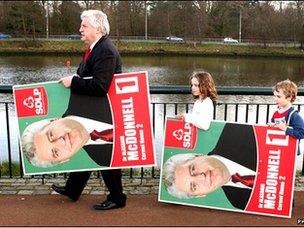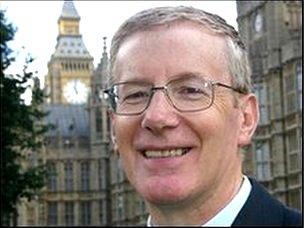NI boundary changes threaten big political names
- Published

Alasdair McDonnell's Belfast seat is to be abolished
The Boundary Commission's initial proposals, published on Tuesday morning, reshape Northern Ireland's political geography more drastically than any changes since the 1980s.
This round of changes has come early due to the coalition government's decision to cut the House of Commons to 600.
It rather brutally puts two MPs and twelve MLAs out of their jobs, as Northern Ireland is to lose two of its eighteen seats.
The proposals will provoke howls of anguish. The towns of Ballymena, Coleraine, and Banbridge teeter on new borderlines, much of their hinterland hived off into neighbouring constituencies.
The new North Antrim and Mid Ulster seats both include wards from five different local council districts.
But because of the rigid rules on keeping an equal number of voters in each constituency, such anomalies were inevitable.
While the process is open to public consultation, it is difficult to see more than minor changes being made to the current map before it becomes law.
To be personal, the two MPs whose seats are most at risk from these proposals are Alasdair McDonnell of the SDLP and Gregory Campbell of the DUP.
Mr McDonnell's South Belfast seat is carved up between the new South East and South West Belfast constituencies, with the Carryduff area going into Strangford.
None of these is good territory for his party, and it is difficult to see how he can find the votes to stay in office. The SDLP's two other seats, Foyle and South Down, have only minor changes and should be safe.
Vulnerable
As the largest party, the DUP were always likely to take a hit if the number of seats is reduced. Gregory Campbell sees his East Londonderry seat rebranded as the new Glenshane constituency, losing Coleraine, Portstewart and Portrush to North Antrim, and gaining instead Magherafelt and points south.

DUP MP Gregory Campbell may struggle to retain his Westminister seat
On my calculations, that leaves the DUP on less than a quarter of the vote in the new area, with Sinn Fein on almost 40%.
A single Unionist candidate might have a chance, but would certainly be vulnerable to tactical voting by Nationalists.
Sinn Fein should still hold their five seats. The new South West Belfast seat sheds the Shankill, their weakest area, from the old West Belfast and brings in less unfavourable (though not exactly fertile) territory from Finaghy and the Malone Road.
The western proposals, with the possible exception of Glenshane as noted above, consolidate SF's areas of strength.
While Alliance's Naomi Long will also have a difficult task to retain her East Belfast seat in its new South East Belfast guise, the Boundary Commission's proposals are not as bad for her as some of the alternatives, losing DUP-dominated Dundonald and bringing in much of South Belfast.
For the UUP, there is no Westminster seat in prospect; the most likely winner in North Down, if Lady Sylvia Hermon does not stand again, is the DUP.
These changes will also impact the Assembly, which will be reduced from 108 members to 96. My projections indicate that the DUP, being the largest party, is hit hardest, losing up to five of its MLAs; the other parties will each lose one or two seats in the Assembly as a result of the boundary changes (as opposed to the will of the voters).
Whether to cut the number of Assembly members still further remains an open question.
The Northern Ireland Assembly in the 1970s and 1980s had only 78 members; electing five MLAs rather than six from each of the proposed sixteen seats would take us back down to 80.
- Published13 September 2011